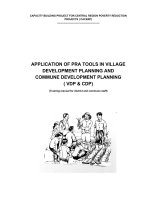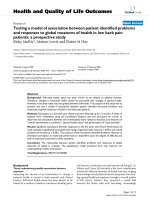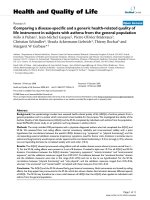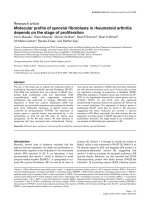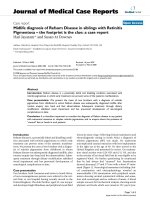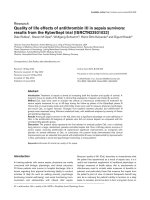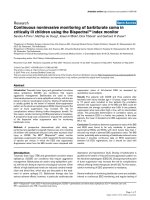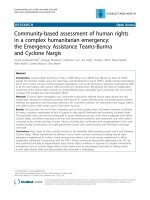- Trang chủ >>
- Khoa học xã hội >>
- Báo chí
Application of ICT tools in communicating information and knowledge to artisanal fishermen communities in Zanzibar
Bạn đang xem bản rút gọn của tài liệu. Xem và tải ngay bản đầy đủ của tài liệu tại đây (547 KB, 16 trang )
Knowledge Management & E-Learning, Vol.9, No.2. Jun 2017
Application of ICT tools in communicating information and
knowledge to artisanal fishermen communities in Zanzibar
Ronald Benard
Frankwell Dulle
Sokoine University of Agriculture, Tanzania
Knowledge Management & E-Learning: An International Journal (KM&EL)
ISSN 2073-7904
Recommended citation:
Benard, R., & Dulle, F. (2017). Application of ICT tools in
communicating information and knowledge to artisanal fishermen
communities in Zanzibar. Knowledge Management & E-Learning, 9(2),
239–253.
Knowledge Management & E-Learning, 9(2), 239–253
Application of ICT tools in communicating information and
knowledge to artisanal fishermen communities in Zanzibar
Ronald Benard*
Sokoine National Agricultural Library
Sokoine University of Agriculture, Tanzania
E-mail:
Frankwell Dulle
Sokoine National Agricultural Library
Sokoine University of Agriculture, Tanzania
E-mail:
*Corresponding author
Abstract: This article assesses the application of ICT tools in communicating
information and knowledge to artisanal fishermen communities in Zanzibar.
The study was carried out in four purposefully selected wards in Unguja
District in Zanzibar, Tanzania. The study involved a sample size of 80
respondents. Data were collected by using document reviews, questionnaires,
focus group discussions and personal observations. Results showed that
artisanal fishermen need information and knowledge on weather condition,
modern fish capturing methods, market and marketing, fish preservation and
processing. The study also found that mobile phones and radio are the most
ICTs tools used by the artisanal fishermen. The findings also revealed that
communicating information and knowledge through ICT tools was limited by
lack of funds, poor network connectivity, lack of training and seminars on the
use of ICTs in accessing information and poor coverage on radio and television
transmission. It is therefore recommended that the government should support
artisanal fishermen in acquiring some of the fishing gears and ICTs tools such
as GPS and sonar through subsidizing them.
Keywords: Artisan fishermen; ICT tools; Information needs; Information and
knowledge communication; Zanzibar; Tanzania
Biographical notes: Ronald Benard is a Lecturer at the Sokoine University of
Agriculture. His research areas include Information management, Information
Management Systems, Agricultural Information and communication,
Communication technology for development and Record Management.
Frankwell Dulle is an Associate Professor at the Sokoine University of
Agriculture (SUA) and Research Fellow of the University of South Africa
(UNISA). He holds a B.Sc. agriculture degree from SUA; Master degree in
library and information studies of the University of Botswana; and a PhD
(Information Science) of the University of South Africa. His research interests
include: Information and Communication Technologies for education and
research; Technology adoption studies; Information and communication
management; and Knowledge management.
240
R. Benard & F. Dulle (2017)
1. Introduction
Tanzania is well gifted with water resources including three of the largest and most
important inland lakes (Lake Victoria, Tanganyika and Nyasa) in Africa, numerous
wetlands, and a diverse river system and an ocean coast-line. The country is reasonably
rich in inland fishery and marine resources and therefore a significant fisheries sector
(Elizabeth, 2007). Fisheries is one of the economic sub sectors of the country, which
provides substantial income, employment, livelihoods, recreation, foreign earnings and
revenues to the country. In 2010, the fisheries sector in Tanzania contributed 1.5% to
GDP and about 10% of the national export (Planning Commission, 2012).
In Zanzibar, a fishery is basically composed of artisanal fishing units, mostly
operating in inshore waters of both Unguja and Pemba Islands. In 2012, fishing industry
in Zanzibar contributed 7.2% to GDP which was insignificant when compared to other
sectors (Minister of State, 2015). The sector employs about 34,000 small scale fulltime
fishers directly and about 4000 people are involved in other fisheries related activities
such as fish processing, fish marketing, fish trade, boat building and maintenance and
fishing gear mending (Ministry of Livestock and Fisheries Development, 2012).
For any activity to be achieved, adequate information and knowledge is required.
Munyua (2000) viewed information and knowledge as the least expensive input for rural
development. Information and knowledge is regarded as a basic and essential ingredient
for bringing about social and economic change in rural areas (Morris, 2000). According
to Lesaona-Tshabalala (2001), information and knowledge is a powerful tool in
addressing fishery needs and if it is used appropriately, it can radically change a nation’s
economy. Artisanal fishermen require a variety of fishery information and knowledge in
order to meet the modern day challenges of fish production, processing, marketing and
distribution (Annune, Ezeani, & Okafor, 2014). According to Uzezi (2015a), information
and knowledge enables fishermen to enhance their fishing practices and yields. Despite
its potential, Ozowa (1995) argued that the vital role played by scientific and technical
information for agricultural and industrial development in developing countries is still
neglected and accorded a lower status compared to other sectors. This view is also
supported by Alam and Haque (2014) who opined that most of the farmers in rural areas
still lack of information and modern agricultural knowledge.
Information and Communication Technologies (ICTs) can be defined as tools that
help in processing, communication and spread of information and knowledge through
electronic devices. ICT tools offer opportunity for rapid and cost effective dissemination
of fishery information and knowledge to remote locations and diverse population
(Kapange, 2010). ICT has given essential mechanism for disseminating knowledge and
information as an input for modern fish farming (Jones & Garforth, 1997).
Moreover, given the potentials shown by ICT tools in communicating and
disseminating of fishery information and knowledge to rural and urban communities, it is
not known to what level such tools have been used in communicating and disseminating
of fishery information and knowledge to fishermen communities in Zanzibar and
especially in Unguja Region. Therefore, the current study was set to assess the level of
usage of ICTs in communicating and disseminating of fishery information and
knowledge to artisanal fishermen in Zanzibar Tanzania.
1.1. Problem statement and justification
In fishery industry, the role of information and knowledge in enhancing fishery
development cannot be underestimated. Information and knowledge is vital in increasing
Knowledge Management & E-Learning, 9(2), 239–253
241
production and improving marketing and distribution strategies (Oladele, 2006).
According to Mtega and Benard (2013), good information increases decision-making,
enhances efficiency and provides a competitive edge. Artisanal fishermen need basic
information and knowledge on their fish capture activities so as they can improve their
yield. Pertiwi, Haluan, and Sari (2002) stated that for improved fish yield, artisanal
fishermen require information on fish species, available resources in each catching area,
fishing season, sources of credit, fish catching technologies, fish processing and storage.
In essence, information is power, and when acquired, communicated and utilized can
help to increase fish production rate among members in fishing communities (Ugboma,
2010). Moreover, Annune et al. (2014) reported that artisanal fishermen lack access to
fishery information and knowledge that could assist them to improve their productivity.
Poor accessibility of information and knowledge among the artisanal fishermen can have
a negative impact in fish production rate. In this regard, the use of ICTs in accessing and
communicating fishery information and knowledge to artisanal fishermen is of great
importance. According to Qureshi et al. (2014), ICTs can be used to transfer information
and knowledge to fishermen community and provide all the necessary fishery
information about different fishing activities and upcoming events.
Despite the potential shown by ICT tools in disseminating and communicating of
information and knowledge to both urban and rural dwellers, it is not known how these
tools are used to facilitate communication of information and knowledge to artisanal
fishermen communities in Zanzibar and specifically in Unguja District. Therefore, the
current study aimed at assessing how ICTs tools can facilitate easy access and
communicating of fishery information and knowledge among artisanal fishermen in
Zanzibar. Specifically, the study aimed at:
Identifying information and knowledge needed by artisanal fishermen in the
study area.
Ascertaining the ICTs usage level in the study area
Determining the challenges associated with use of ICTs by artisanal fishermen
1.2. Conceptual framework
This study was guided by the modified Mtega and Benard (2013) conceptual framework
which indicates how ICT tools are used in communicating information and knowledge to
the community as outlined in Fig. 1. With reference to this study, the usage of
information/knowledge depends on its perceived usefulness in fisheries and related
activities.
The conceptual framework for this study links various cultural, ICT infrastructure,
economic, social influence, individual, social and institutional variables necessary for the
usage of rural information services. The perceived usefulness of ICT tools among fishery
communities is influenced by the user’s economic profiles, cultural, social, and the
availability of ICTs access points. ICT infrastructure, institutional involvement and types
and quality of fishery information and knowledge provided may equally have effect on
the level of usage of ICT tools. Therefore, this conceptual framework guided the present
study in assessing how ICT tools are used in communicating and disseminating
information and knowledge to artisanal fishermen and hence improving fishery practices.
242
R. Benard & F. Dulle (2017)
Fig. 1. The modified conceptual framework adopted from Mtega and Benard (2013)
2. Literature review
This section presents the reviewed literature on the study topic. The review is organized
around broad themes and covers the following; knowledge and information needs of
artisanal fishermen, ICTs usage by artisanal fishermen, and challenges facing artisanal
fishermen in accessing fishery information and knowledge through ICTs.
2.1. Information needs of artisanal fishermen
Information need is an individual or group aspiration to locate and obtain information to
satisfy a conscious or unconscious need (Taylor, 1962). Likewise, Devadason (1996)
postulated that information need represents gaps in the current knowledge of the client.
The findings by Uzezi (2015b) and Kaduskar, Nair, and Ashok (2009) revealed that the
information needs of artisanal fishermen vary and range from where to get fishing gears,
how to control water hyacinths, where to sell fish/fish products, how to use improved
modem fishing techniques, and information about fish price in market.
2.2. ICTs usage by artisanal fishermen
Information and Communication Technologies (ICTs) play an important role in socio
economic development of the fishermen. Several studies have been conducted on the use
of ICTs by fishermen in communicating fishery information and knowledge. For
instance, a study conducted by Abraham (2007) in India on the use of mobile phones in
the fishing industry found that artisanal fishermen were able to discuss the price of their
catches with dealers in advance via mobile phones hence accessing better price
opportunities and preventing unnecessary catch wastes. In Asian countries, fishermen
have improved their income as well as living standards. Through the use of GPS system,
Knowledge Management & E-Learning, 9(2), 239–253
243
the artisanal fishermen have saved their time in finding locations while usage of sonar has
increased their product (Walsham, 2010). Likewise, a study by Ibeun and Mdaihli (1994)
on the utilization of the ICTs in Kainji area in Nigeria revealed that 56% of the fishermen
had their own radio and half of respondents listened to radio at fishing area sites. About
11% of the fishermen reported to benefit from the radio programs in terms of boosting
their knowledge and obtaining latest information regarding market prices. Studies
conducted in Ghana by Jensen (2007) show that more than half of the 71% fishermen
indicated that mobile phones helped them stay in touch with their buyers and customers;
this was apart from getting fishery information from other markets.
There are no studies done to show how ICTs facilitate communicating
information and knowledge among artisanal fishermen in Tanzania and particularly
Zanzibar. Most of the studies that have been done in Tanzania on the use of ICTs have
focused on other categories such as crop farmers, livestock keepers, students excluding
artisanal fishermen. This study, therefore, intended to assess the use of ICTs by artisanal
fishermen in communicating information and knowledge to fishery community and
consequently improving their livelihoods.
2.3. Challenges facing artisanal fishermen in communicating information and
knowledge through ICTs
Several challenges in communicating information and knowledge through ICTs by
fishermen community have been reported. For example, Omar, Abu Hassan, Shaffril,
Bolong, and D’Silva (2011) indicated that fishermen communities are facing many
challenges and hindrances in ICT usage including the high costs particularly of computer
and sonar. Also, a study by Hosseini, Niknami, and Chizari 2009) mentioned
technophobia, lack of expertise, negative attitude about modern technology, low number
of service centers in rural areas, low bandwidth, lack of hardware, and lack of appropriate
infrastructure. Other cited challenges include: low number of web sites, weak
telecommunication systems, old telephone lines and low quality of service provided by
the service centers as the challenges which hinder fishermen communities from using
ICTs (Hosseini et al., 2009). Moreover, the study by Abraham (2007) revealed that
fishermen were mostly uneducated and had no proper knowledge about use of ICTs such
as mobile phones and other new technologies including GPS and Sonar in sea. Likewise,
Yonah (2005) mentioned that finance and lack of awareness among most of fishermen on
the use of ICTs for information sharing were the main limitations constraining fishermen
from ICTs usage. The negative attitude towards ICT usage is one of the problems
hindering ICTs usage among fishermen (Omar et al., 2011).
3. Research methodology
A cross-sectional research design was used for this study. The design was chosen because
it allows a researcher to collect data at once in a single point. Four wards namely
Kikungwi, Kaepwani, Tindini and Uzi in Unguja region were studied. Unguja region was
selected since it is among the areas in Zanzibar with high development ICTs
infrastructure and fishing activities as compared to other regions.
Both random and non-random sampling techniques were used in this study.
Purposive sampling method was used to select the wards and villages to be involved in
the study area. According to Johnson and Christensen (2004), purposive sampling relies
on the decision of the researcher focusing on some well-known criteria. The four wards
244
R. Benard & F. Dulle (2017)
for this study were selected purposively. These wards were selected due to the fact they
were among the areas in Unguja where fishing activities were in a large scale (RGZ,
2014). From each ward, one village was selected purposively making a total of four
villages. The sampling procedure required the construction of a sampling frame.
Therefore, the sampling frame was constructed and it included all households involved in
fisheries. The sampling frame was constructed with assistance from village government
offices through Village Executive Officers (VEOs). Hence, 20 respondents were
randomly chosen from each village and thus making a total sample size of 80
respondents. Singleton, Straits, and Straits (1993) argued that a sample or sub sample of
30 respondents is the bare minimum for studies in which statistical data analysis can be
done.
In this study, face- to -face interviews were administered to 80 respondents. Both
closed and open ended questions were included in the questionnaire. Interviews, Focus
Group Discussion and personal observation were also done with some of the key
informants to supplement information gathered. Four (4) key informants were involved in
interviews while eight (8) participated in Focus Group Discussions. The quantitative data
collected through questionnaires were coded and summarized prior to analysis by using
the Statistical Product Service Solution (SPSS) version 20. The researchers’ employed
descriptive statistics, such as frequencies, percentages in data analysis. Qualitative data
was analyzed using content analysis.
4. Results
This section presents the research results and the discussion of the findings. The findings
presentation and discussion is based on objectives of the study.
4.1. Background characteristics of respondents
The results in Table 1 summarize socio-economic characteristics of the respondents.
Findings show that all respondents involved in the study were males. This implies that
most of the artisanal fishermen in the study area were males. This might be due to the
nature of the activity as in most cases fishing is normally carried out by males. This is
confirmed by the study by Okwu, Yahaya, and Obinne (2011) who also found that most
the fishermen were men. Furthermore, the results reveals that about (36.2%) of the
respondents were in the 31-40 age group; 22.5% were aged between 21- 30 years; 16.2%
were aged between 41-50 years; and 11.2% were aged between 41-60 years. This
indicates that most of the respondents were in their active age. Likewise, the findings
reveal that about 50% of the respondents were married, 24% of the respondents were
single, 12% of the respondents were divorced and 4% of the respondents were separated.
This indicates that majority of the respondents in the study area were from married
couples.
Further, results show that majority of the respondents (45%) had completed
secondary education, 9.2% reported to have never attended any school, 21.2 % of
respondents had primary education, and 33.8% had no formal education. This means that
the respondents were moderately educated and majority could read and write that they
could receive and share fisheries information through various ICTs sources.
With respect to the income levels of respondents, the results reveal that (73.8%)
respondents earned an annual income above 400,000 Tshs per annum, 8.8% respondents
had an income of less than 100,000 Tshs per annum, 7.5% had an income ranging from
Knowledge Management & E-Learning, 9(2), 239–253
245
300,001 to 400,000 Tshs per year, 6.2% respondents earned an annual income ranging
from 200,001to 300,000 Tshs per annum while 3.8% of the artisanal fishermen earned an
income ranging from 100,001 to 200,000 Tshs per annum. This indicates that majority of
the respondents in the study area did not earn adequate income to meet their daily
expenditures. It was for this reason fishermen reported to involve themselves in other
extra economic activities including seaweeds farming which give them extra income.
This can have negative impacts on usage of ICTs usage and accessibility of
information/knowledge. This was supported by fisheries officer who said that fishermen
with good fish harvests always made mobile phone calls asking for different fishery
information and knowledge. Swanson (1997) also supports that income influence usage
of some information sources among farmers.
Table 1
Socio-economic characteristics of the respondent (N=80)
Variable
Sex
Age (years)
Marital status
Education
Annual income
Working experience(years)
Category
N
%
Male
80
100
Female
0
0
Below 20
11
13.8
21 to 30
18
22.5
31 to 40
29
36.2
41 to 50
13
16.2
51 to 60
9
11.2
Single
24
30.0
Married
40
50.0
Divorced
12
15.0
Separated
4
5.0
No formal education
27
33.8
Primary education
17
21.2
Secondary education
36
45.0
Less than 100,000
7
8.8
100,001-200,000
3
3.8
200,001-300,000
5
6.2
300,001-400,000
6
7.5
More than 400,000
59
73.8
Less than 5 years
6
7.5
5-10 years
35
43.8
10- 16 years
16
20.0
17- 22 years
13
16.2
22 years and above
10
12.5
246
R. Benard & F. Dulle (2017)
Moreover, the research findings reveal that 43.8% respondents had a fishing
experience of 5 -10 years, 20% respondents had an experience of 5-16 years, 16.2% had
an experience of 17 - 22 years while 12.5% of the fishermen had a fishing experience of
22 years above. This signifies that artisanal fishermen in the study area had enough
fishing experience on which may be shared to fellows through ICTs. To a large extent,
experience affects know-how as well as the use of different extension methods including
ICTs (Ani, 2006).
4.2. Information and knowledge needs of artisanal fishermen
The results in Table 2 summarize the information and knowledge needs of artisanal
fishermen. The findings reveal that majority of artisanal fishermen (95%) indicated that
they needed information and knowledge on weather condition and modern fish capture
method, 92.5% needed information and knowledge on marketing, 91.3% needed
information on fishing gears and maintenance, fish preservation and processing. It was
further revealed that 83.8% respondents needed information and knowledge on
credits/loan, 66.3% fishermen needed information and knowledge on fish species, 60%
needed information and knowledge on fishing rights and laws, while 52.5 % needed
information and knowledge on breeding seasons. Findings from interviews with fishery
extension officers and FGDs reported almost similar information needs, except that they
added to need information and knowledge on how to use some ICT tools such as GPS
and sonar for fishing activities.
Table 2
Information and knowledge needs of artisanal fishermen
Types of information
N
%
Weather conditions
76
95.0
Information on credit/ loans
67
83.8
Marketing
74
92.5
Fish species
53
66.3
Breeding seasons
42
52.5
Fish preservation and processing
73
91.3
Fishing gear and maintenance
73
91.3
Modern fish capture method
76
95.0
Fisheries rights and laws
Multiple responses
48
60.0
4.3. ICTs usage level in the study area by artisanal fishermen
The findings in Table 3 indicate that the level of usage of ICTs in communicating
information and knowledge to artisanal fishermen in the study area. The results show that
(82%) fishermen used mobile phones followed by those (, 50%) who used radio sets to
access information and knowledge while 82.5%, 78.8% and 55% artisanal fishermen
claimed to have never used sonar, internet/computer and GPS respectively in
accessing/communicating information and knowledge.
Knowledge Management & E-Learning, 9(2), 239–253
247
Table 3
ICTs usage level in the study area by artisanal fishermen
Types of ICTs
Highly
Moderate
Low
N
%
n
%
Radio
40
50.0
31
38.8
3
Mobile phone
66
82.5
8
10.0
0
Television
9
11.3
44
55.0
Internet/computer
0
0.0
9
GPS
1
1.3
Sonar
0
0.0
Never used
n
%
3.8
6
7.5
0.0
6
7.5
23
28.8
6
7.5
11.3
63
78.8
5
6.3
27
33.8
44
55.0
8
10.0
0
0.0
66
82.5
14
17.5
4.4. Challenges facing fishermen on the use of ICTs in accessing fishery
information and Knowledge
Findings on Table 4 reveal that majority of artisanal fishermen encountered problems
when communicating information and knowledge through ICTs. The problems faced
include lack of funds 95%, poor network connectivity and lack of training and seminars
on the use of ICTs in accessing information 90%, poor coverage on radio and television
transmission 87.5%, and high cost of acquiring and maintenance ICT facilities 87.5%.
Other challenges experienced include lack of knowledge on how to use ICTs 86.5%, lack
of support from the government 72.5%, and lack of awareness on the potential of ICTs
for disseminating fishery information 72.5%, lack of interest on listening and watching
television 71.3% and language problem 58.8%. It was also proved from interview and
Focus Group Discussions that inappropriate time on television and radio broadcasting,
irrelevance of television programmes and lack of funds as the main challenges.
Table 4
Challenges facing fishermen on the use of ICTs in accessing fishery information and Knowledge
Challenges
n
%
Lack of knowledge on the use of ICTs
69
86.3
High cost of acquiring and maintenance ICTs facilities
70
87.5
Language problem
47
58.8
Lack of training and seminars on the use of ICTs in accessing information
72
90.0
Lack of funds
76
95.0
Poor coverage on radio and television transmission
70
87.5
Poor network connectivity
72
90.0
Lack of awareness on the use of ICTs for disseminating fishery information
58
72.5
Availability of electricity
39
48.8
Lack of interest on listening and watching television
57
71.3
Lack of support from the government
58
72.5
248
R. Benard & F. Dulle (2017)
5. Discussion
This section presents a detailed discussion of the research findings of this study.
5.1. Information and knowledge needs of artisanal fishermen
The findings revealed that artisanal fishermen needed information and knowledge on
weather condition, modern fish capturing method, market and marketing, fish
preservation and processing, fishing gears and maintenance and information on
credits/loan. This signifies that artisanal fishermen lack access to information and
knowledge on weather condition which is very important for their fishing activities
mainly in this era of climate change. However, this is not in line with findings from
Okwu et al. (2011) who reported that high percent of artisanal fishermen in Nigeria had
information and knowledge on weather condition. The discrepancy can be probable due
to differences on economic development between the two countries. Similarly, the study
revealed that most fishermen did not know where and how to use modern fish capturing
methods. This implies that artisanal fishermen still relied on traditional fishing capturing
methods. This was proved by observation in fishing sites as very few fishermen were
using modern fish capturing methods. This is probable because of lack of information and
knowledge on where and how to use them also lack of funds to purchase them. Similar
findings are reported by Okwu et al. (2011) who found that majority artisanal fishermen
needed information and knowledge on how and where to obtain modern fish capturing
method. This information is very vital for fishermen since it enables them to improve
their fishing activities and consequently raising their incomes.
Likewise, most of the artisanal fishermen complained about lack of information
on marketing. This indicates that they lacked access to information on markets of their
fishery products. This was confirmed by one of the fishery officer who claimed that some
of the fishermen used to harvest a lot of pearls but they did not know where to sell them.
These findings are in line with those of Uzezi (2015a) who recorded that majority of the
artisan fishermen needed information on where to sell fish or fish products. Therefore,
responsible organs should take it into consideration since it can have negative impact on
fishermen’s social economic development. Also, most of artisanal fishermen reported
about insufficient information and knowledge on fish preservation and processing. This
reveals that artisanal fishermen lack information and knowledge on how and where to
store/preserve their fish/fish products. This is supported by Barguma and Ndaghu (2014)
who found that one of the challenges faced by fishermen was poor knowledge on fish
processing and preservation. Knowledge and information on how to process and preserve
fish is very crucial to fishermen since fish is one of the perishable food which need
necessary attention on its processing and storage/preservation.
Furthermore, the majority of artisanal fishermen mentioned to need information
and knowledge on fishing gears and maintenance. This indicates that artisanal fishermen
did not get information and knowledge on where and how to use fishing gears and on
repair/maintenance. This could retard their efforts in improving fishing activities. This is
agreed by Uzezi (2015b) who asserted that poor fish farming practices among fishermen
account for their inability to use modern fishing gears. Moreover, the study revealed that
most fishermen did not know where and how to obtain credit and loan facilities. This in
line with Njoku (2004) who also found that knowing where and how to obtain credit
facilities remained to be the most important need of the artisanal fishermen. This implies
that artisanal fishermen did not receive any information concerning credits and loan
facilities. This situation could have a negative impact on their fishery practices.
Knowledge Management & E-Learning, 9(2), 239–253
249
5.2. ICTs usage level in the study area by artisanal fishermen
The main ICT tools used for communicating information and knowledge to artisanal
fishermen were mobile phones and radio. This implies that majority of artisanal
fishermen preferred using mobile phones in communicating information and knowledge
regarding fishery practices. This is supported by Omar et al. (2011) who pointed out that
most of the fishermen in Malaysia used mobile phones in communicating information
and knowledge related to fishing activities with colleagues, agency officers and dealers in
the fishing communities. This is probable because mobile phones are s more interactive
and in most cases they always enhance a two-way traffic in a communication process. In
such cases, fishermen can be communicating any information and knowledge to their
colleagues or other information sources and acquire instant feedback. Abraham (2007)
noted that fishermen are able to discuss the price of their catches with dealers in advance
via cellphones hence access to better price opportunities and prevention of unnecessary
catch wastes. Therefore, there is a need for the government to improve ICTs
infrastructure especially in rural areas so that more fishermen can make use of mobile
phones.
Likewise, it was noted that artisanal fishermen were using radio as a medium for
communicating information and knowledge related to fishery activities. This signifies
that fishermen were accessing information and knowledge related to fishing activities
through radio listening. This supported by Qureshi et al. (2014) who recorded that radio
is the mostly used ICT tools for getting the informing and knowledge about fish farming.
The reason could be that radio is readily available, affordable and reaches a wide
audience even in remote areas. This was observed by researcher through field observation
whereby majority of fishermen had their own radio sets. Thus, radio is an effective
medium for communicating and disseminating the latest fishery knowledge and
information or technology to fishermen. Fishermen involved in the study mentioned radio
sets to help them to gain new knowledge and improve their fishing practices.
However, results revealed that majority of the artisanal fishermen had never used
sonar, internet/computer and GPS to access and communicating fishery information and
knowledge. These findings differ from those of Mittal, Gandhi, and Tripathi (2009), and
Teh, Teh, and Meitner (2012) who described that GPS and Sonar were the most ICT tools
used by fishermen in India in obtaining the fishery information. This difference can be
accounted by differences in advancement of ICT infrastructure, lack of skills, lack of
awareness of the role of the Internet as an important source of fishery information,
limited education and income among fishermen in the current study area. This is not
surprising as for example, Malhan and Rao (2007) also reported that ICTs such as
Internet, GPS and Sonar are less used in developing countries due to poor information
infrastructure and the poverty level of rural communities which does not allow them to
invest in ICTs. In view of this, there is a need to invest in rural ICT infrastructure and
training in basic ICT skills which could enable fishermen to use such tools to access
information that could improve their fishery practices and hence raising their standard of
living.
5.3. Challenges on ICTs usage
The main problem faced by artisanal fishermen in communicating fishery information
and knowledge was lack of funds. This implies that lack of funds limited fishermen from
communicating information and knowledge at the study area. This was supported by one
of the fishery officer during interview who mentioned to have failed to conduct seminars
250
R. Benard & F. Dulle (2017)
on ICTs usage to fishermen due to lack of funds. This can be the source for low usage to
some of the ICT tools such as GPS and sonar because fishermen cannot afford to
purchase them. Likewise, poor network connectivity was another challenge. This was
confirmed during Focus Group Discussion as fishermen complained about poor internet
connectivity and television signals. Also, this could be reason for low usage of internet
and television. This finding is in conformity with Mtega and Malekani (2009) who
mentioned poor network connectivity as the main factor hindering information
accessibility among farmers in rural areas. This situation can have negative impact on
information and knowledge accessibility and hence poor fishing practices which can
retard fishermen socio-economic development.
Findings further revealed that lack of training and seminars on the use of ICTs in
accessing information was a problem to most of the fishermen. This was proved by the
researcher who observed that few fishermen possessed GPS but they complained about
lack of knowledge on how to use it. This means that fishermen did not get seminars and
trainings on how to use some of the ICT tools. Training is very important in order to keep
fishermen update in using different ICT tools for communicating fishery knowledge.
Chhachhar, Qureshi, Khushk, and Pathan (2014) opined that there is a need for capacity
building through providing ICTs trainings among fishermen. Moreover, high cost of
acquiring and maintenance ICT tools was also highlighted by most of the artisanal
fishermen as the main constraints. For instance, during focus group discussions, some of
the fishermen were complaining about high cost of purchasing GPS and Sonar, and
television sets. This could contribute to low usage of such tools in the study area. Njoku
(2004) noted that ICTs tools are very expensive and poor community have no access to
purchase and use it. Similarly, lack of knowledge on the use of ICTs to communicate
information and knowledge was another challenge. This is in agreement with Levy and
Banerjee (2008) who observed that majority of the fishermen live in rural areas and most
of them have no idea or knowledge on how to use ICTs for accessing information. Other
constraints mentioned by majority of artisanal fishermen were lack of support from the
government and lack of awareness on the use of ICTs for disseminating fishery
information.
6. Conclusion and recommendations
From the research findings of this study, it can be concluded that artisanal fishermen need
information and knowledge in order to improve their fishery practices. They need
information and knowledge on weather condition, modern fish capturing method, market
and marketing, fish preservation and processing, fishing gears and maintenance and
information on credits/loan. This study has also demonstrated that mobile phones and
radio are the most used ICT tools by the artisanal fishermen. Conversely, a number of
challenges limited usage of ICT tools especially computer, GPS and the internet. Such
challenges include lack of funds, poor network connectivity, lack of training and
seminars on the use of ICTs in accessing information, poor coverage of radio and
television transmission, high cost of acquiring and maintenance ICT tools, and lack of
knowledge on the use of ICTs. However, to improve usage and access of ICT tools in the
dissemination and communication of fishery information and knowledge for fishery
development in the study area, the following recommendations are made:
I.
The government should empower artisanal fishermen through subsidizing more
modern fishing gears and ICT tools such as GPS and sonar to enable fishermen
to afford and use them.
Knowledge Management & E-Learning, 9(2), 239–253
II.
III.
IV.
V.
VI.
251
Media owners should be encouraged to broadcast more fishery related
programmes on both radio and television.
There is a need for expansion of mobile services operations to adequately cover
the entire Unguja Island that fishing communities may have access to
information and knowledge on fishing. Institutions or agencies involved in
fisheries extension services should take advantage of the opportunity to
mainstream mobile phones in extension and advisory services in the Island.
Librarians should be fully involved in the direct communication and
dissemination of fishery information and knowledge to artisanal fishermen as
professionals.
The government, non-governmental organizations or institutions and related
department and agencies should provide seminars and workshops on how to use
ICTs and fishing gears so as to increase fishermen capacity.
Local or central government authorities should liaise with librarians for
instituting local community information centers/rural libraries in fishing
communities nationwide. This will increase utilization of information and fish
production rate.
References
Abraham, R. (2007). Mobile phones and economic development: Evidence from the
fishing industry from India. Information Technologies and International Development,
4(1), 5–17.
Alam, M. K., & Haque, A. M. (2014). Contribution of television channels in
disseminating agricultural information for the agricultural development of Bangladesh:
A case study. Retrieved from />Ani, A. O. (2006). Potential of oasis for sustainable agricultural production in Yobe State,
Nigeria. International Journal of Agricultural and Bio-logical Sciences, 43(1), 1–5.
Annune, A. E., Ezeani, C. N., & Okafor, V. N. (2014). Information sources dissemination
and utilization patterns of the artisanal fishery sector in Benue State, Nigeria.
Advances in Research, 2(12), 889–905.
Barguma, K., & Ndaghu, A. A. (2014). Information accessibility among fish farmers in
Girei, Yola North and Yola South local government areas, Adamawa State, Nigeria.
ARPN Journal of Science and Technology, 4(8), 503–507.
Chhachhar, A. R., Qureshi, B., Khushk, G. M., & Pathan, M. (2014). Problems in use of
information and communication technology tools among fishermen. Journal of
Applied Environmental and Biological Sciences, 4(6), 164–171.
Devadason, F. J. (1996). Practical steps for identifying information needs of clients.
Paper presented at the 10th Congress of South East Asian Librarians (Cowsal X).
Kuala-Lumpur, Malaysia.
Elizabeth, S. (2007). Agricultural information needs of women farmers in Mubi region,
Adamawa State. Journal of Tropical Agriculture, 45(1), 69–71.
Hosseini, S. J. F., Niknami, M., & Chizari, M. (2009). To determine the challenges in the
application of ICTs by the agricultural extension services in Iran. Journal of
Agricultural Extension and Rural Development, 1(1), 27–30.
Ibeun, M. O., & Mdaihli, M. (1994). Media of communication among fishermen around
Kainji lake Basin. Nigeria: New Bussa. ISBN 978-037-000-5
Jensen, R (2007). The digital provide: Information (technology), market performance,
and welfare in the South Indian fisheries sector. The Quarterly Journal of Economics,
252
R. Benard & F. Dulle (2017)
122(3), 879–924.
Johnson, R. B., & Christensen, L. B. (2004). Educational research: Quantitative,
qualitative, and mixed approaches. Boston, MA: Allyn & Bacon.
Jones, G. E., & Garforth, C. (1997). The history, development, and future of agricultural
extension. In B. E. Swanson, R. P. Bentz, & A.J. Sofranko (Eds.), Improving
Agricultural Extension: A Reference Manual (pp. 3–12). Rome: Food and
Agricultural Organization of the United Nations.
Kaduskar, M., Nair, V., & Ashok, A. (2009). Understanding mobile usage in rural India
-'09. Retrieved from />Kapange, B. (2010). ICTs and national agricultural research systems –The case of
Tanzania.
Retrieved
from
/>Lesaona-Tshabalala, B. V. (2001). Agricultural information needs and resources
available to agriculturists and farmers in a developing country with special reference
to Lesotho. Master thesis, Rand Afrikaans University, South Africa.
Levy, M. R., & Banerjee, I. (2008). Urban entrepreneurs, ICTs, and emerging theories: A
new direction for development communication. Asian Journal of Communication,
18(4), 304–317.
Malhan, I. V., & Rao, S. (2007). Agricultural knowledge transfer in India: A study of
prevailing communication channels. Library Philosophy and Practice. Retrieved from
/>Ministry of Livestock and Fisheries Development. (2012). Endorsement of the
management plan for the Tanzanian artisanal fishery for small and medium pelagic
species. the United Republic of Tanzania, Dar es Salaam.
Minister of State. (2015). Zanzibar research Agenda: 2015-2020. Second Vice
President’s
Office, United
Republic of Tanzania. Retrieved
from
/>Mittal, S., Gandhi, S., & Tripathi, G. (2009). Impact on small farmers and fishermen
through use of mobiles in India. In Proceedings of EAAE-IAAE seminar on small
farms. University of Kent, UK.
Morris, C. (2000). The role of computers and information technology in rural
agricultural
information
system.
Retrieved
from
/>Mtega, W. P., & Malekani, A. W. (2009). Analyzing the usage patterns and challenges of
telecenters among rural communities: Experience from four selected telecenters in
Tanzania. International Journal of Education and Development using ICT, 5(2), 68–
87.
Mtega, W. P., & Benard, R. (2013). The state of rural Information and communication
services in Tanzania: A meta-Analysis. International Journal of Information and
Communication Technology Research, 3(2), 64–73.
Munyua, H. (2000). Information and communication technologies (ICTS) for rural
development and food scarcity: Lesson from field experience in developing countries.
Paper presented at a workshop on the role of information and communication
technologies in rural development and food security.
Njoku, I. F. (2004). The information needs and information-seeking behaviour of
fishermen in Lagos State, Nigeria. International Information & Library Review, 36(4),
297–307.
Okwu, O. J., Yahaya, M. A., & Obinne, C. P. O. (2011). Analysis of artisanal fisher folk
information needs and accessibility in Benue State, Nigeria. Asian Journal of
Agricultural Sciences, 3(5), 408–413.
Oladele, O. I. (2006). Multilinguality of farm broadcast and agricultural information
access in Nigeria. Nordic Journal of African Studies, 15(2), 199–205.
Knowledge Management & E-Learning, 9(2), 239–253
253
Omar, S. Z., Abu Hassan, M., Shaffril, H. A. M, Bolong, J., & D’Silva, J. L. (2011).
Information and communication technology for fisheries industry development in
Malaysia. African Journal of Agricultural Research, 6(17), 4166–4176.
Ozowa, V. N. (1995). Information needs of small scale farmers in Africa: The Nigerian
example. Consultative Group on International Agricultural Research (CGIAR) News,
4(3), 10–12.
Pertiwi, S., Haluan, J., & Sari, E. Y. (2002). Construction of marine resource database for
empowering small scale fishermen. In Proceedings of the 3rd Asian Conference for
Information Technology in Agriculture. Beijing, China.
Planning Commission. (2012). The Tanzania long-term perspective plan (LTPP ): The
roadmap to a middle income Country. President's Office, United Republic of
Tanzania.
Retrieved
from
/>2/LTPP_2012-03-19_PRINT.pdf
Qureshi, B., Pathan, M., Chandio, F. A., Keerio, A., Buriro, R. A., & Chhachhar, A. R.
(2014). Adoption of information communication technology tools among fishermen.
Journal of American Science, 10(7), 155–161.
Singleton, R. A., Straits, B. C., & Straits, M. M. (1993). Approaches to social research.
New York: Oxford University Press.
Taylor, R. S. (1962). The process of asking questions. Journal of the Association for
Information Science and Technology, 13(4), 391–396.
Teh, L. C. L., Teh, L. S. L., & Meitner, M. J. (2012). Preferred resource spaces and fisher
flexibility: Implications for spatial management of small-scale fisheries. Human
Ecology, 40(2), 213–226.
The Revolutionary Government of Zanzibar (RGZ). (2014). Zanzibar fisheries policy
(First draft prepared with the support of SmartFish). Retrieved from
/>ers/cluster_1/agriculture/2._Ag_policies_and_strategies/Zanzibar_Ag_policies/3._201
4_Zanzibar_Fisheries_Policy__first_draft_-_18_June_2014_.pdf
Ugboma, M. U. (2010). Access to agriculture information by farmers in Niger Delta
region of Nigeria, Delta State. Library Philosophy and Practice. Retrieved from
/>Uzezi, O. P. (2015a). Agricultural and information needs and utilization among migrant
fishermen by gender: A study of Isoko reverie community, Delta State, Nigeria.
Journal of Emerging Trends in Computing and Information Sciences, 6(5), 263–267.
Uzezi, O. P. (2015b). Information needs and seeking behavior of migrant fishermen: A
case of Isoko riverine communities Delta State, Nigeria. International Journal of
Scientific & Technology Research, 4(8), 284–288.
Walsham, G. (2010). ICTS for the broader development of India: An analysis of the
literature. The Electronic Journal of Information Systems in Developing Countries,
41(4), 1–20.
Yonah, Z. (2005). ICTs as tools for poverty reduction. In Proceedings of the Discourse
on Engineering Contributions to the Reduction of Poverty.

